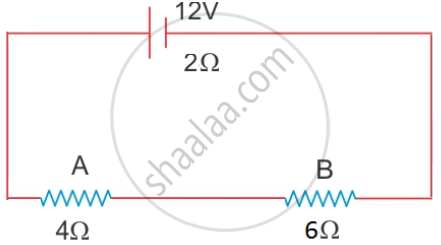Advertisements
Advertisements
प्रश्न
A current of 5 amperes flows through a wire whose ends are at a potential difference of 3 volts. Calculate the resistance of the wire.
उत्तर
Here:
Current, I = 5 A
Potential difference, V = 3 V
Substituting these values in the Ohm's equation, V/I = R:
Resistance of the wire, R = 3/5 = 0.6 Ω
APPEARS IN
संबंधित प्रश्न
Calculate the quantity of heat produced in a 20 Ω resistor carrying 2.5 A current in 5 minutes.
A battery of emf 12 V and internal resistance 2 Ω is connected with two resistors A and B of resistance 4 Ω and 6 Ω respectively joined in series.

Find:
1) Current in the circuit
2) The terminal voltage of the cell
3) The potential difference across 6Ω Resistor
4) Electrical energy spent per minute in the 4Ω resistor.
The p.d. across a lamp is 12 V. How many joules of electrical energy are changed into heat and light when:
a charge of 1 C passes through it?
Ohm's law state a relation between potential difference and ___________.
How is the electric potential difference between the two points defined? State its S.I. unit.
Define the term ‘volt’.
From the following observations taken while determining the resistance of a conductor, draw the current-voltage graph and calculate the resistance of conductor. Is the conductor ohmic?
| Ammeter reading I (in ampere) | Voltmeter reading V (in volt) |
| 0.2 | 0.4 |
| 0.3 | 0.6 |
| 0.5 | 1.0 |
| 0.8 | 1.6 |
| 1.5 | 3.0 |
Which of the following represents voltage?
An electric charge always flows from a point at a ______ to a point at a ______.
Electric potential is a measure of the ______ on the unit positive charge to bring it to that point against all electrical forces.
